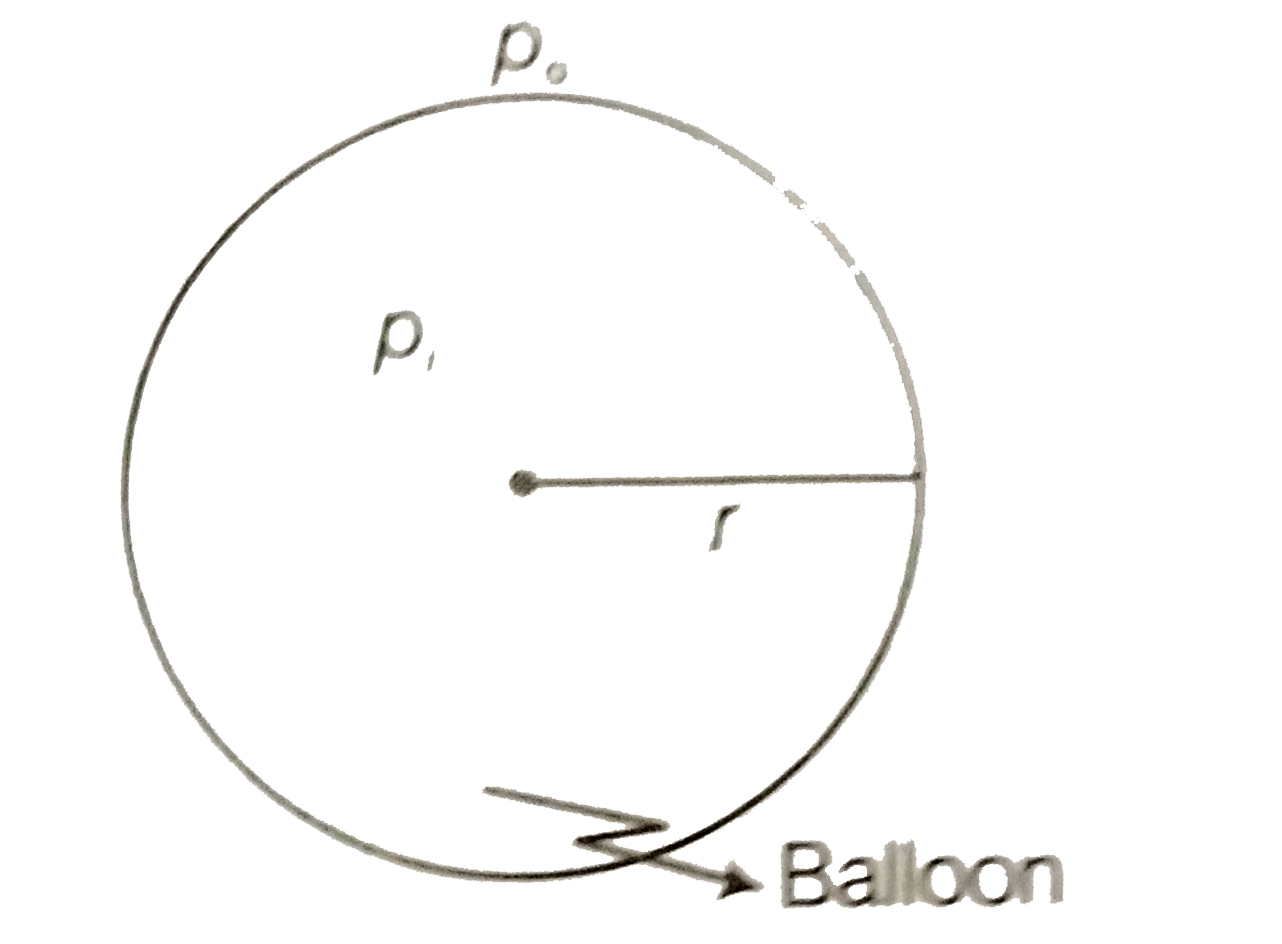A hot air balloon is a sphere of radius 8 m . The air inside is at a temperature of 60∘C. How large a mass can the balloon lift when the outside temperature is 20∘C? (Assume air is an ideal gas R=8.314Jmole−1K−1,1atm.=1.013×105Pa , the membrane tension is 5Nm−1)
Let the pressure inside the balloon be pi and the outside pressure be p∘, then excess pressure is pi−p∘=2Sr .
Where , S=Surface tension
r=radius of balloon

Considering the air to be in ideal gas piV=niRTi where, V is the volume of the air displaced and n∘ is the number of moles displaced and T∘ is the temperature outside.
So, ni=PiVRTi=MiMA
Where, Mi is the mass of air inside and MA is the molar mass of air
and n∘=P∘VRT∘=M∘MA
Where, M∘ is the mass of air outside that has been displaced . If w is the load it can raise, then w+Mig=M∘g
⇒w=M∘g−Mig
As in atmosphere 21% O2 and 79%N2 -is present
∴ Molar mass of air
Mi=0.21×32+0.79×28=28.84g
∴ Weight raised by the balloon
w=(M∘−Mi)g
⇒w=MAVR(P∘T∘−PiTi)g
=0.02884×43π×83×9.88.314(1.013×105293−1.013×105333−2×58×313)
=0.0288443π×838.314×1.013×105(1293−1333)×9.8
=3044.2N
∴ Mass lifted by the balloon =wg=3044.210≈304.42 kg .
≈305kg.
Topper's Solved these Questions
- MECHANICAL PROPERTIES OF FLUIDSBook:NCERT EXEMPLAR ENGLISHChapter:MECHANICAL PROPERTIES OF FLUIDSExercise:Short Answer Type Questions
Explore 5 Videos
- LAWS OF MOTIONBook:NCERT EXEMPLAR ENGLISHChapter:LAWS OF MOTIONExercise:Long answer Type Questions
Explore 9 Videos
- MECHANICAL PROPERTIES OF SOLIDSBook:NCERT EXEMPLAR ENGLISHChapter:MECHANICAL PROPERTIES OF SOLIDSExercise:LONG SHORT ANSWER TYPE QUESTION
Explore 16 Videos
Similar Questions
Five moles of an ideal monoatomic gas with an initial temperature of 150∘C expand and in the process absorb 1500 J of heat and does 2500 J of work. The final temperature of the gas in .∘C is (ideal gas constant R=8.314JK−1mol−1)
View SolutionOne litre of dry air STP undergoes through an adiabatic process and reaches to a final temperature of 89.6 °C, the work done by air is : [Take air to be an ideal gas and γair=1.4 use R=8.3Jmol−1K−1]
View Solution
Knowledge Check
What is the activation energy for a reaction if its rate doubles when the temperature is raised from 20∘C to 35∘C? (R=8.314Jmol K−)
A269kJ mol−1B34.7 kJ mol−1C15.1kJ mol−1D342kJ mol−1The r.m.s. velocity of hydrogen at 27∘C,R=8.314Jmol−1K−1 is:
A1.934m/sB19.34m/sC193.4m/sD1934m/sWhat is the activation energy for a reaction if the rate is doubled when the temperature is raised from 20∘ C to 35∘C (R=8.314Jmol−1K−1)
A15.1 kJ mol−1B342kJmol−1C269kJmol−1D34.7kjmol−1
What is the activation energy for a reaction if its rate doubles when the temperature is raised from 20∘C to 35∘C?
(R=8.314 J mol−1K−1)
View SolutionWhat is the activation energy for a reaction if its rate doubles when the temperature is raised from 20∘C to 35∘C? (R=8.314Jmol K−)
View SolutionFive moles of an ideal monoatomic gas with an initial temperature of 150∘C expand and in the process absorb 1500 J of heat and does 2500 J of work. The final temperature of the gas in .∘C is (ideal gas constant R=8.314JK−1mol−1)
View SolutionA reaction has an activation energy of 209 KJ mol−1 . The rate increase 10-fold when the temperature is increased from 27∘C to X∘C . The temperature X is closed to
[Gas constant, R =8.314Jmol−1K−1]
View SolutionOne litre of dry air STP undergoes through an adiabatic process and reaches to a final temperature of 89.6 °C, the work done by air is : [Take air to be an ideal gas and γair=1.4 use R=8.3Jmol−1K−1]
View Solution
